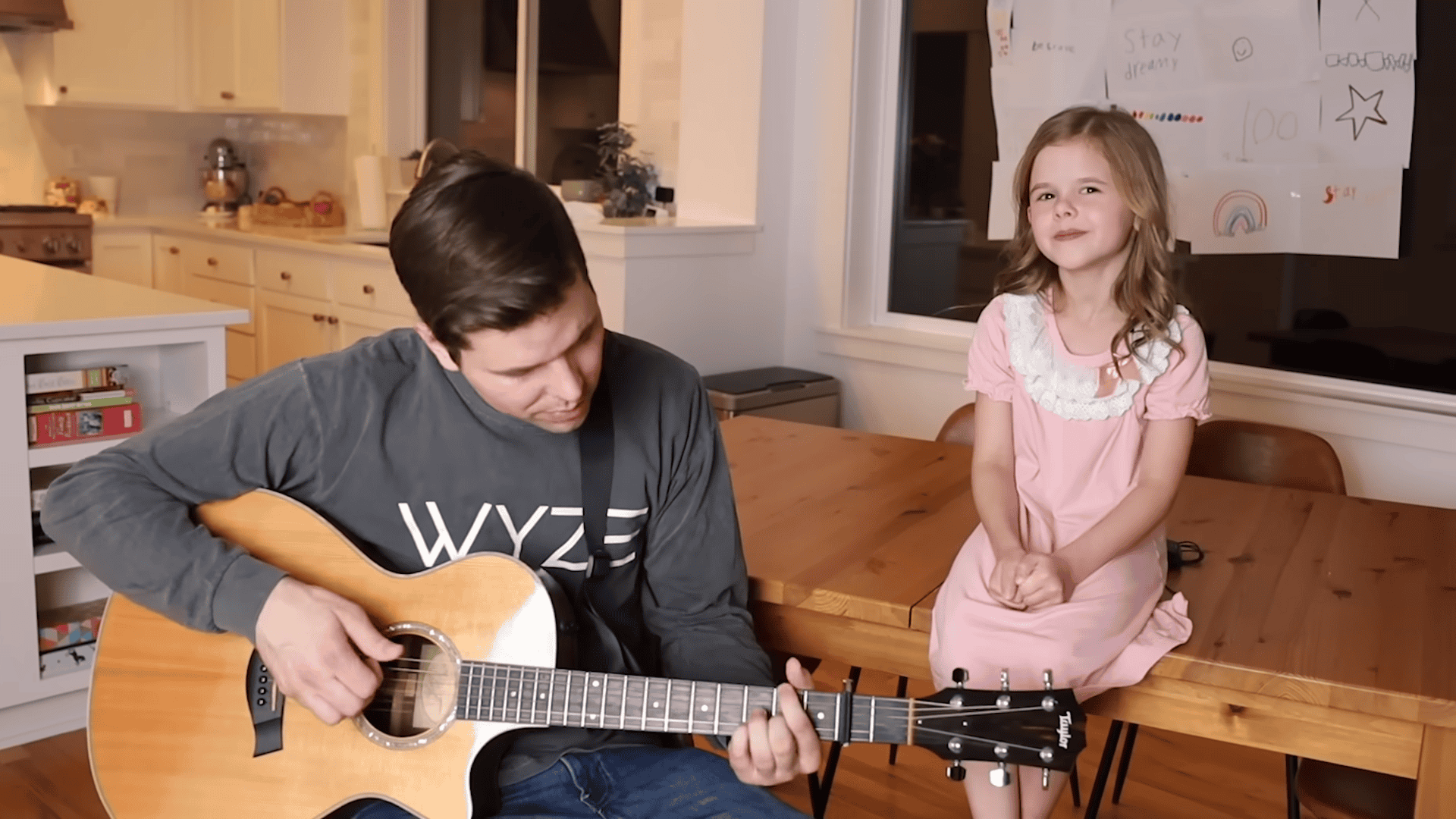Guitar has an extra removeable neck.
Everyone knows that first gentle strum of Stairway to Heaven. The legendary Led Zeppelin ballad is one of those songs that’s woven into the fabric of music history. Why touch it? For some, that familiarity makes it almost untouchable. For others, it’s a canvas calling for new expression.
Luca Stricagnoli is one of those rare artists brave enough to answer that call. With his love for fingerstyle guitar and a knack for building his own tools, Luca doesn’t just cover Stairway to Heaven, he makes it entirely his own. In this post, discover the magic and meaning behind Luca’s “Reversed Slide Neck” cover, which reimagines a classic with invention, emotion, and jaw-dropping skill.
A New “Stairway:” Luca Stricagnoli’s Unique Take
It’s no secret that Stairway to Heaven is one of the most played, and overplayed, songs in music stores and jam sessions. Still, Luca sees it as a piece worth loving. He has said that even with its reputation for being everywhere, the song is close to his heart.
Luca’s approach isn’t just about playing the notes. He sets out to give the song a totally fresh voice, showing fans a side of the classic they may not expect. His bold vision and innovative tools bring a sense of wonder back to a track that’s almost mythical.
With fingers dancing across strings and his focus set deep, Luca’s performance isn’t just technique. It’s a story retold, new and surprising, even for die-hard Zeppelin fans.
What Makes the Reversed Slide Neck Different?
From the moment Luca appears on screen, it’s clear his guitar isn’t ordinary. Connected to the top sits another neck: the Reversed Slide Neck (RSN). To most, it looks puzzling, but for Luca, it unlocks a world of sound.
The RSN stands out in a few key ways:
- Mounted Backwards: Unlike a regular guitar neck, the RSN points in the opposite direction, flipping expectations as well as strings.
- Slide on Binaries: There’s a slide attached, moving along rails (or “binaries”), letting Luca create haunting, fluid notes with the touch of a finger.
- Removable and Quick: The RSN snaps onto a standard guitar and can be removed in seconds, a true add-on, not a permanent part.
This creation gives Luca the power to blend melody and harmony in a completely original way, especially when reinterpreting songs as beloved as Stairway to Heaven.
Reversed Slide Neck at a Glance
| Feature | Description |
|---|---|
| Direction | Opposite to regular guitar necks |
| Slide System | Mounted on rails for smooth movement |
| Attachment | Removable, snaps on in seconds |
| Creator | Designed by Luca Stricagnoli, built by Davide Serracini |
One summer night, Luca sketched out his wild idea for a reversed neck on paper. Some would have shrugged it off. Instead, he brought in luthier Davide Serracini, who helped him make the vision a reality. Together, they turned an idea into a working instrument.
Now, Luca and Davide hope to bring the RSN to guitarists everywhere. They are open to taking orders, but only if enough players show interest. Anyone craving the RSN’s unique tones can reach out to Luca directly at info@lucastricagnoli.com.
Want to learn about the craftsman behind the RSN? Check out Davide Serracini’s work.
This spirit of inventiveness isn’t just about technical accomplishment. It’s about bringing personal stories and fresh imagination to the songs that shaped a generation.
For most of the cover, Luca’s hands race across the modified guitar. But when it’s time for the legendary solo, another of his inventions takes center stage: the Soprano Guitar.
This instrument doesn’t sit upright like most guitars, instead, it rests horizontally. With high-pitched strings tuned in scale, it almost sings rather than plays. Its sweet, crisp voice cuts through, echoing the original solo but spinning it into something gentle and haunting.
Luca’s used this custom Soprano Guitar in other performances, but here it shines in a special way. “The Soprano Guitar’s sound turns the solo into something both nostalgic and fresh,” one viewer noted. In Luca’s hands, it’s not just a solo. It’s a conversation between past and present.
For this arrangement of Stairway to Heaven, the Soprano Guitar steps up only for the solo, serving as a secret ingredient that’s heard more than seen.
Every music video is woven from a web of talent. This one pulls together artists, technicians, and creators from across Europe.
Filming and Direction
Luca didn’t just play. The video’s visual storytelling came alive thanks to Meg Pfeiffer, who framed every flourish and close-up. Her keen eye creates an intimate mood, you feel as if you were in the room with Luca, watching his fingers skip across the wood.
Credits for Meg Pfeiffer:
Recording and Mixing
Getting that rich, alive sound takes more than strings and wood. Proton Studio handled the audio engineering, capturing the ring of every note and the subtle slide of every hand. Learn more about their expertise at Proton Studio.
Filming Location
The performance was shot at Teckstudio, whose cozy, inspiring studio space wraps the whole session in warmth and focus. Peek into their creative environment at Teckstudio.
Strings and Capos
To sound just right, Luca relies on gear from D’Addario, from strings to the capo holding everything in place. Find out what makes their products a favorite among acoustic players at D’Addario.
A breakdown of the team behind this video:
- Videography and Direction
- Audio
- Mixing and recording by Proton Studio
- Location
- Shot at Teckstudio
- Instruments and Gear
- Custom guitars by Davide Serracini
- Strings and capos by D’Addario
Great art is never made alone. Each member of the team shaped the sound, look, and feel of what may feel at first like a simple “cover,” but is something far more.
For fans who want to follow along with Luca’s latest projects, performances, and behind-the-scenes glimpses, he’s easy to find online. His social media is a window into the creative process, full of short snippets, tour updates, and personal insights.
Here’s where you can connect with Luca directly:
Luca’s site doesn’t just offer news and contact info. It’s the spot to check out tour dates, access tabs for his arrangements, and find details for booking inquiries. Booking requests and questions about inventions like the RSN can go to info@lucastricagnoli.com.
Luca’s “Stairway to Heaven” cover isn’t limited to YouTube. Fans can listen and support the song across Spotify, iTunes, and every major online music store. Spreading the word and streaming the track is a way to help fresh, original music reach more ears.
Support for artists making their own mark on classics ensures that future covers, perhaps even more unexpected and heartfelt, get made.
Watching Luca’s performance, you can feel more than just skill. There’s something personal behind every note. The room is quiet, maybe a little tense, as he picks up that strange, doubled guitar. Silence fills the air, broken only by the first gentle strum.
Luca’s brow furrows, lost in the music. His hands move with a kind of joy, but also respect, he knows the legacy of this song, the millions who have tried (and the few who have really found something new inside it).
The video catches more than music. It shows a moment: the thrill of doing what seems impossible, the hope that someone out there will see the beauty in doing it differently. That’s why this cover isn’t just impressive. It’s moving. A musician faced with a mountain of history chooses to build a ladder from his own inventions, and climb anyway.
Conclusion
Luca Stricagnoli didn’t have to tackle Stairway to Heaven. He certainly didn’t have to invent new gear to do it. But by choosing the hard road, and making new tools, he reminds us what great music can be: a conversation with the past, a challenge to do better, and a chance to uplift others.
For anyone who loves seeing classic songs come alive in new ways, this cover stands as both tribute and inspiration. It’s proof that invention and heart can breathe new life into music we thought we already knew.
Follow Luca, listen to the magic, and let yourself be surprised, sometimes the best covers are the ones no one saw coming.






